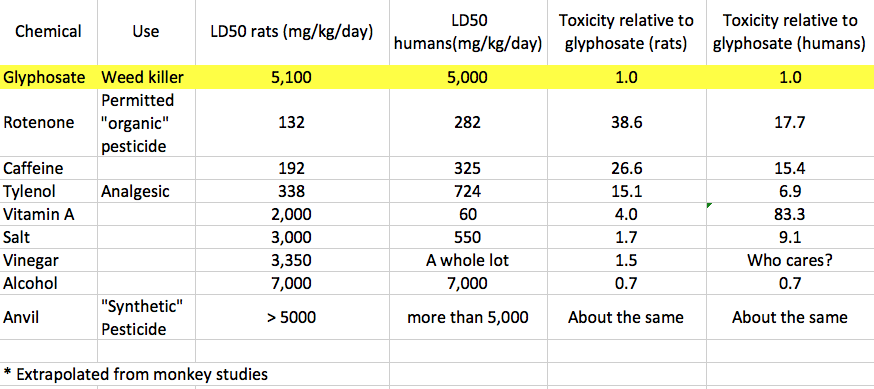The winner in this
month’s “I need a chemistry lesson, and fast” award goes to Anthony Dunton of
Acworth, Georgia. Hands down.
Dunton was arrested
last week for trying to poison a co-worker by putting the weed killer Roundup
(glyphosate) into his water.
Let’s just give him
mixed grades on this one. Dunton denied trying to kill the man, but, rather,
just “mess with him.” In this regard, Dunton actually did a splendid, albeit
clearly unintentionally job. “Mess with” is probably not going to be a
marvelous defense once this gets to court, and scientifically it makes even
less sense.
Why? If you want to
pick a poison to put into someone’s water it would be really hard to do
a worse job. For this, we can give credit to Dunton’s apparent lack of
scientific acumen, which he must have gotten from militant environmental
groups, such as EWG and NRDC.
So, how poisonous
is glyphosate? If you are a chemist or a toxicologist you already know but if
you are an anti-science activist you will be surprised. Acute toxicity of a
chemical is measured using a parameter called LD50—the dose at which 50 percent
of the animals or humans will die. The higher the number, the less toxic the
chemical is. The following table will probably surprise you, and perhaps even
relieve you, since, unless you’re a weed.
Basically, there is
no way to get enough glyphosate into a glass of water to kill you. LD50 numbers
are expressed in mg/kg body weight of the animal/day. So, for a chemical that
has an LD50 of 1000 mg/kg/day in humans (70 kg), the daily dose required to kill half of the people would be 70 grams (2.5 ounces, one teaspoon).
So, how good was Mr. Dunton’s choice of poisons? Just about as bad as humanly possible. Which should be evident from the table below: Yes, what you are seeing is real. The two “chemicals from hell” are designed to kill bugs and weeds. And they are safer than just about all the products you consume every day.
has an LD50 of 1000 mg/kg/day in humans (70 kg), the daily dose required to kill half of the people would be 70 grams (2.5 ounces, one teaspoon).
So, how good was Mr. Dunton’s choice of poisons? Just about as bad as humanly possible. Which should be evident from the table below: Yes, what you are seeing is real. The two “chemicals from hell” are designed to kill bugs and weeds. And they are safer than just about all the products you consume every day.

Yes, what you are
seeing is real. The two “chemicals from hell” are designed to kill bugs and
weeds. And they are safer than just about all the products you consume every
day.
What have worked
better instead was an organic pesticide. Like rotenone—one of the insecticides
that are “permitted” for use in “organic farming.” If you are buying organic
food, there is a good chance rotenone was used to kill the bugs that would have
otherwise eaten the crops. Yet, rotenone is 20-40 times more toxic than
glyphosate.
So is Anvil—another
no-no in the world of pseudoscience. It is so safe that a toxic dose cannot even be reliably established. (Exception: Anvil is toxic to cats. Be extra careful that they don’t consume it).
So why did he
choose so poorly? Judging by the marketing efforts of their political science
majors, environmental groups are just as misguided. If you want to poison
someone, glyphosate is a terrible choice because it would have taken about 350
grams (three quarters of a pound) to (maybe) do the job. That wouldn’t even fit
into the water bottle.
If anyone can make
even the slightest bit of sense out of this, please speak up. And, you should
also send Mr. Dunton a note. After all, if you’re in the mood to poison someone,
you might as well do it properly. It would have taken about 350 grams (three
quarters of a pound) to (maybe) do the job. Wouldn’t even fit into the water
bottle he tried to poison.
Mr. Dunton is not
the only one who needs a chemistry lesson. Our dear friends over at NRDC and
EWG ought to sign up as well. Worse still, they portray themselves as
scientists. And, we wonder if Dunton got his “information” from these guys,
because that would be the ultimate irony.
According to EWG: “Glyphosate is spreading like a cancer across the U.S.” And the NRDC thinks that banning glyphosate is going to “save the whales.” Nope. Not kidding.
According to EWG: “Glyphosate is spreading like a cancer across the U.S.” And the NRDC thinks that banning glyphosate is going to “save the whales.” Nope. Not kidding.
No comments:
Post a Comment